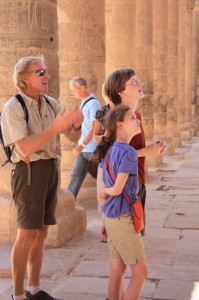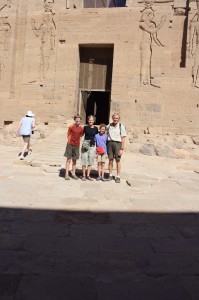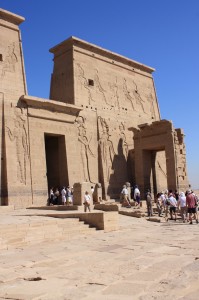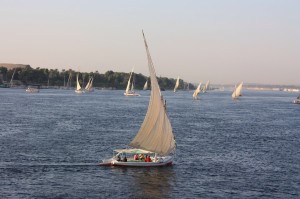On the night of the fourth, we boarded the night train to Aswan. We originally had planned on taking a day train, the night train differential costing much more than the price of a nice hotel, but we found out that foreign tourists were not allowed on the day train. The ostensible reason given is that they cannot provide security to foreigners on the day train. I guess thieves and terrorists like to sleep at night, so night trains are not such a worry.
Aswan is in southern Egypt, near the ancient border with the land of Kush, now mainly Sudan. It is probably most famous for being the site of the Aswan High Dam, a controversial project that brought flood control, plentiful, cheap electricity, a lot of environmental problems, and cold war political intrigue with the Soviet Union and the US. It also flooded a lot of old Egyptian temples. The UN, along with a lot of foreign archaeologic teams, ended up coming in to help save many of the temples. They actually dismantled many of the major temples and then moved them to higher ground. One of the most impressive, Philae Temple, was not moved until about 12 years after the dam was built. By that time, a coffer dam had to be built around the temple, the water pumped out, the temple dissasembled, and then rebuilt on another nearby island that had been greatly excavated to resemble the original site. We visited it, along with hoards of other tourists, while we were there. I must say that I think the effort, as big as it was, was well worth it. The temple was the last built by a native pharaoh in about 350 BC, with additions to the complex continuing until about 300 AD, under a Roman Emperor. It is extremely well-preserved, with extensive hieroglyphics and decorations covering the walls and even the ceiling.
Another great site was the Nubia Museum, also built with UN help. It contains artifacts including pottery, stone carvings, and pharonic statues from the area dating back as far back as 6,500 years ago. Coming from a country where something 200 years old is very unusual, 6,500 years is unimaginable.
In addition we visited Elephantine Island, an ancient town set in the middle of the Nile facing Aswan. Abu, an ancient temple complex there that was dedicated to Khnun, the god of inundation, is still in the process of being excavated. It is not as impressive as some of the other Aswan temples, but is still very interesting. It looks more like what you expect from a 5,000 year old temple.
Later that day we took a sunset cruise on a felucca boat that sailed around Elephantine Island. A felucca sail is a must-do on a trip to Egypt. It is very affordable, and being out on the Nile is a real treat. You will not have to search someone out for a sail, either, as you cannnot avoid being approached by someone offering to take you on a ride. Repeatedly. Even after saying no, you will be asked many more times. Even if you tell them you have already been on a felucca sail, you will be asked many more times. In our case, we came to an understanding with “Captain Kiwi”, though we did not set the time. Later, when we were approached by another person for a ride, we told him we were going with CK, and he told us that he was his cousin, and they shared a boat, and that he was supposed to be the one taking us on the sail. Not seeing CK before the time of our sail, we went with the man, though we were skeptical he really was his cousin, because the comment about somebody being their cousin is made to us daily. Either there are only a few giant families in Egypt, or the definition of cousin is mighty loose. When we saw CK the next day, he asked why we had not gone on the sail with him. His “cousin” was apparently news to him. At any rate, our felucca trip was wonderful, as it was a beautiful time of the day to be on the Nile, with great colors from the low light on the surrounding hills, and the river covered with sailboats, all listing with the wind. It was scheduled as a one hour trip, but the winds died, and we ended up taking two hours, with the last half hour spent rowing. It was a memorable evening, marred only by the effort of the felucca captain to extract even more money from us when we arrived back, despite the fact I paid double what we had agreed to because the trip took two instead of one hour. Oh well. That is life in Egypt.
On our last day in Aswan, we booked a cruise on the Nile to our next destination, Luxor. Initially we booked a “5 star” cruise for three nights. When we went to look at the ship the day before we were to depart, we found the ship to not be as advertised. The decor appeared to be from the 60’s or 70’s, and it had not had a good cleaning since that time. We were bummed, as a Nile cruise was something that Margit, in particular, had been looking forward to. We both, though, felt that it was not worth anything near what they were asking for that ship. The agent assured us that there was not another one in Aswan with openings, as everything was booked up. Fortunately, we had been in Egypt long enough to know that that was not necessarily true, and sure enough, Margit found another cabin for less money on a much nicer boat. The ship was what I expected from a Nile cruise, like something out of Agatha Christie’s novel, “Death on the Nile”. Like everything in Egypt, though, it was not as straight-forward as we thought. That, however, is a story for another blog. Margit will tell that story.
Mitch
15 November 2010




Trackbacks/Pingbacks
https://www.youtube.com/watch?v=5Im2WNyf3mg…
Latest Telugu Hot Short films 2016…